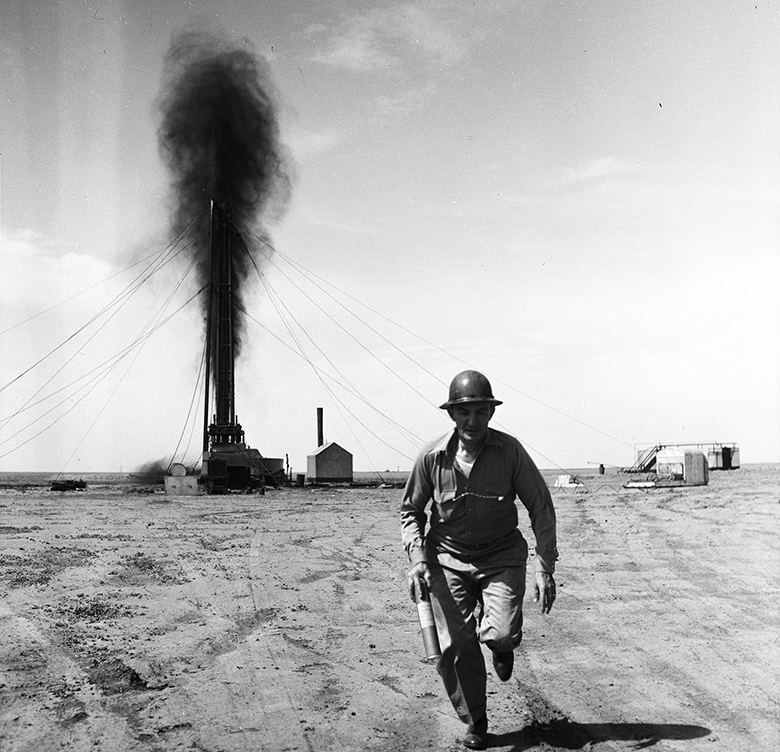Ten years ago this week—July 11, 2008 to be exact—the price of a barrel of oil on the New York Mercantile Exchange hit an intraday high of $147.27, its highest price ever. By the following autumn the world economy was in shambles and the price of oil was tumbling. The oil price eventually bottomed out around $34 per barrel in mid-February the following year.
Oil prices started 2002 around $20 per barrel and then rose almost continuously until mid-2008. As they rose, the world’s best known critic of peak oil* prognostications, Daniel Yergin, began to look so foolish for having predicted ample supplies for decades to come that his firm finally reversed itself in mid-2008 and began to forecast higher prices. That should have been read as a contrarian signal; just two months later the oil bull market ended.
Peak oil thinkers at the time believed that their forecast of a nearby all-time peak in the rate of world oil production had been fulfilled. The official numbers seemed to confirm this. Petroleum geologist Kenneth Deffeyes’ had made a half-serious prediction that Thanksgiving Day 2005 would mark the all-time high for production. Production of crude oil including lease condensate (which is the definition of oil) was slightly more than 74 million barrels per day (mbpd) in December 2005, but thereafter declined.
Despite high and rising prices oil production failed to exceed that number for two years. In December 2007 production inched above the previous high mark and stayed there through July 2008, the month the oil price peaked. That month the world produced slightly more than 75 mbpd.
In August production fell by more than one million barrels and did not surmount 75 mbpd until two years later.
Robust demand in an era of stagnant supply had sent prices spiraling upward. Those high prices became a contributory cause of the worst economic calamity since the Great Depression. A moment of high drama seemed to coincide with the peak oil moment in world history.
But what if peak oil is a process rather than a moment, a process with a series of twists and turns filled with sometimes ambiguous and counterintuitive signals? If so, it might look something like what followed.
When the economy rebounded and oil prices rebounded with it, the peak oil thesis seemed reconfirmed. The International Energy Agency had noted in its 2010 World Energy Outlook (page 48) that the rate of production of conventional oil had, in fact, peaked in 2006 and that unconventional supplies would thereafter have to provide the world’s oil supply growth.
As it turned out, world oil production plateaued bouncing between 73 and 76 mbpd until late 2013. Not surprisingly, this constrained supply brought on high prices. In fact, the years 2011 through 2014 experienced the highest ever average daily prices for crude oil, higher than the average for the year of the price spike.**
This fact, however, was obscured by the fawning media coverage of increasing supplies of shale oil in the United States (properly called tight oil) which did little to stem the price rise.
One lonely voice, petroleum geologist and consultant Art Berman, pointed out that the companies drilling for this oil were almost all free cash flow negative—even as oil prices levitated over $100 per barrel and stayed there. (Free cash flow is operating cash flow minus capital expenditures.)
Berman said the economics just didn’t support bringing the shale oil out of the ground. But investors didn’t listen and kept handing new investment capital in the form of both equity and debt financing to the drillers. Without this capital the drillers would not have been able to continue growing their production since their operating cash flow from existing wells came nowhere near the amount needed to grow production.
Today, we know that Berman was right. This fact became more apparent when oil prices declined in 2014 and kept going down. Several drillers went bust. But even as much of the industry remains on life support, those companies currently drilling in the Permian Basin in Texas are involved in yet another bizzare free-cash-flow-negative boom. The Permian has become a Wall Street darling even though it’s actually the latest place where capital goes to die.
Two countries, Canada and the United States, have been largely responsible for growth in world oil production since 2005. The extra oil came mostly from the tar sands in Canada and the tight oil fields of the United States. Oil production rose smartly in both countries as long as prices stayed aloft. But the price decline that began in 2014 and ended with Brent Crude at $26 on January 20, 2016 caused Canadian output to stagnate and U.S. production to decline.
Output in both countries has now rebounded with U.S. production eclipsing the production peaks of the previous boom. Almost all production growth is coming from the Permian Basin in Texas where a drilling frenzy fueled by the flood of new capital mentioned above continues.
Berman’s analysis of the Permian details financial conditions that no peak oil thinker could ever have imagined. Let’s take a few moments to see why this is so.
One of the criticisms of peak oil thinking is that it doesn’t take into account economic factors. A second criticism is that it fails to recognize so-called unconventional oil resources such as tar sands, tight oil, heavy oil and arctic oil. Both criticisms are false, at least as they apply to the top-tier thinkers such as petroleum geologist Colin Campbell.
As far back as 1996 Campbell recognized that high oil prices would dampen oil consumption and delay or draw out the peak. But neither he nor other thinkers believed that unconventional oil resources could do anything more than soften the rate of decline in worldwide production. The reason was that such resources would be expensive and difficult to extract and would therefore not enter the market quickly enough to overcome the decline of conventional oil production.
Now here is what peak oil thinkers couldn’t foresee: That investors would subsidize the production of vast amounts of oil rather than seeking a return on their capital and that they would do this year after year even in the face of the obvious financial evidence. Essentially, Wall Street has been subsidizing the consumption of oil on Main Street.
That this is unsustainable is obvious. Eventually, investors will realize that there is no long-term value in tight oil. For now the flood of oil from tight oil formations has conjured the illusion that the world needn’t worry about oil supplies anymore because of the “miracle” of hydraulic fracturing, often referred to as fracking. (Why investors have been cautious about additional investment in the Canadian tar sands, but not American tight oil is a truly puzzling question.)
The recent rebound in oil prices should spur some investment elsewhere, especially where genuine financial returns await. But the punishing price decline in oil from 2014 to 2016 and the slow recovery that followed has resulted in deep cuts in exploration and development throughout the industry (if not so much in the U.S. tight oil fields).
In response the International Energy Agency has been waving its arms for some time that this dearth of investment will mean constrained supplies after 2020. In addition, Rystad Energy, an independent energy research firm, reported at the end of last year that 2017 saw a record low in oil discoveries. It noted that exploration expenditures had dropped 60 percent from 2014 to 2017. Without a substantial reversal of this trend, the firm expects supply deficits. (Translation: There won’t be enough oil to go around in the not-too-distant future.)
Meanwhile, writer Gail Tverberg has been pounding home her counterintuitive thesis that peak world oil production won’t be accompanied by high prices. Rather, it will be the result of prices too low for much of the remaining oil to be extracted profitably. In other words, in Tverberg’s opinion there isn’t an oil price that is both low enough to avoid economic stagnation (i.e., a price that consumers can readily afford) and yet high enough to incentivize oil companies to extract sufficient quantities of oil to prevent a decline in the overall rate of production worldwide.
It seems the first part of her analysis is proving correct with regard to tight oil production and probably deepwater and arctic oil. But the fact that tight oil extraction remains by and large free cash flow negative and yet continues to attract investment has obscured her underlying financial logic.
Investors, however, won’t keep subsidizing expensive tight oil extraction for the benefit of the masses indefinitely. As economist Herbert Stein once said, “If something can’t go on forever, it will stop.” When it does stop, one of three things will emerge:
- New extraction technologies will have lowered the cost of tight oil production sufficiently to bring those costs into alignment with what consumers can afford on a long-term basis.
- Demand for oil will have declined sufficiently because of efficiency or migration to other energy sources, say, electricity for transport, and so the decline of investment flows into oil exploration won’t matter.
- The world will be headed toward, if not already in, its next oil crisis as prices rise to a level that makes tight oil production genuinely profitable.
The first result seems unlikely as innovation cycles are very long in the oil industry, sometimes taking 30 years to reach maturity. The second is possible only in the longer term and only if countries worldwide put themselves on the equivalent of a war footing to speed up their transformation. The third result seems the most probable outcome as the lack of investment in oil exploration is likely to show up in two to three years.
Whether the next oil crisis will mark the all-time peak in worldwide oil production is unknowable. If it does, the reprieve provided by what we now know has been investor-subsidized tight oil will have been a dangerous detour—one that delayed a transition away from oil when the price spike of 2008 and the record high prices of the early part of this decade should have made clear that such a transition was urgent.
_________________________________________
* For the uninitiated, peak oil in this context refers to the moment in time when the worldwide RATE of oil production reaches a peak and thereafter enters a permanent but possibly bumpy decline. It does NOT, as many wrongly claim, mean the world will run out of oil. In fact, oil will continue to be pumped as long as human society has a need for it and can afford its extraction. The cost of using oil as our main energy source, however, may be too great for the economy to bear in the long run after the peak.
** Average daily spot prices for a barrel of Brent crude, the world benchmark, were as follows: 2008, $96.94; 2011, $111.26; 2012, $111.57; 2013, $108.56; 2014, $98.96.
Photo: Tex Thornton. Amarillo, Texas. June 1940. By Robert Yarnall Richie. DeGolyer Library, Southern Methodist University. VIa Wikimedia Commons. https://commons.wikimedia.org/wiki/File:Title-_Tex_Thornton_(8409509954).jpg






